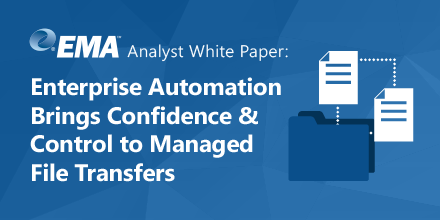One of the most widely performed processes we see people using automation for is file transfer protocols (FTP) or managed file transfers (MFT). According to our 2015 Customer Survey, it is the third most-automated process, with 77% of customers reporting they use IT automation for FTP processes.
The Challenge
While FTP and MFT are a commonplace practice for most, if not all, businesses today, there are several challenges that arise with their use.
For one, FTP does not guarantee delivery or even notification of delivery. This can create problematic delays because even if you think an FTP was successfully delivered, you may not find out days or weeks later that the other party never received the files, or that the file was incomplete.
As a result, businesses run the risk of missing deadlines or breaching SLAs. For example, construction companies often FTP their bids for public and private Requests for Proposals (RFP) to the organization that put out the RFP. If an FTP fails or sends an incomplete file, and the construction company isn’t notified by the other party, they’ve just lost out on the bid process.
FTP also generates a lot of clutter because it doesn’t remove unneeded files once they have been sent. Instead, administrators have to stay on top of the growing-mass of files and manually purge these files.
Many IT organizations rely on siloed FTP management and automation tools, which are far from streamlined or efficient. These FTP tools may be difficult to use and require time-consuming scripting for each operating system. Moreover, they don’t provide the monitoring and alerting organizations need to ensure FTP execution is successful or that the files are complete.
These shortcomings expose organizations to unnecessary business risk such as missed deadlines or missed SLAs from file transfer delays or failures, as well as jeopardizing conventional batch processes that are dependent on the FTP’s successful execution.
Where Workload Automation Comes In:
Workload automation provides extended visibility and control over dependent FTP and non-FTP operations. Automation gives users the ability to securely send FTPs and automatically restart from the point of transmission failure, while providing a centralized alert and monitoring framework to alert IT of problems when they occur.
For example, telecommunications provider Cincinnati Bell needed a more robust automation solution to manage the sending and receiving of data files from banks. Before introducing an automation tool, if a job failed, SQL Server Agent’s limited alerting capabilities meant a problem wouldn’t be discovered until a user logged in manually to check on a process, or worse, a bank called inquiring about a missing or incomplete file.
Cincinnati Bell overcame this challenge by utilizing ActiveBatch to proactively prevent the failure of an FTP before it happens. The team uses ActiveBatch’s built-in alerting to receive an email or text message in the event of an FTP failure. Additionally, in order to proactively check the file prior to it being sent, the team created workflow in which a database query compares the output file from the creation of the file to the database the data is stored in, verifying that the two match before the workflow proceeds to initiate the FTP.

